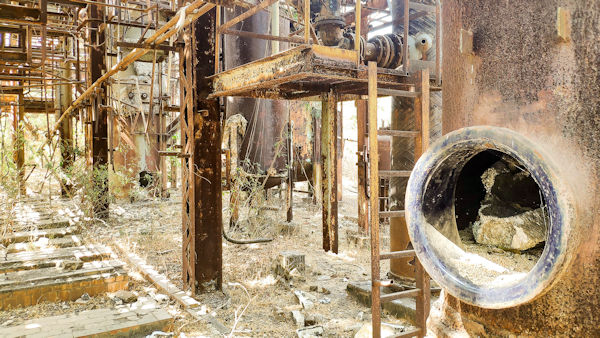SEJournal Online is the digital news magazine of the Society of Environmental Journalists. Learn more about SEJournal Online, including submission, subscription and advertising information.
 |
 |
| Above, the abandoned Union Carbide factory in Bhopal, India, 35 years after the worst-ever industrial disaster prompted the U.S. Congress to pass a series of laws to protect against and inform the public about similar risks. Photo: Bhopal Medical Appeal. Click to enlarge. |
WatchDog Opinion: A Chance To Widen Public Information About Chemical Hazards
By Joseph A. Davis
Should the public know about the deadly threats that chemical facilities may pose to the often vulnerable communities who live around them? The U.S. Environmental Protection Agency is taking a new look at that question. And reporters may want to pay close attention.
Could a silent, green, ground-hugging cloud of chlorine gas kill thousands in their sleep when a valve leaks? Could a leak of deadly hydrofluoric acid from a refinery overwhelm emergency rooms with victims unable to breathe? Could a leak of ammonia refrigerant kill workers in a food-processing plant? Could those propane tanks near a railroad siding explode in a fireball deadly to a neighborhood?
Right now, when it comes to these questions, many communities are virtually in the dark. And that’s the way the chemical industry, Congress and federal regulators seem happy to leave it.
But with EPA’s pending review of a key chemical safety rule, there may be a chance for industry, communities or the media to change the situation. EPA held public listening sessions June 16 and July 13 in anticipation of a proposed rulemaking to update its rule for “Risk Management Plans,” or RMPs, for hazardous chemical facilities.
From Bhopal to RMPs
The backstory here is a long and winding one, too complex to do more than hint at here. It goes at least to the Bhopal chemical disaster of 1984, in which a release of methyl isocyanate killed uncounted thousands in India and injured possibly half a million people. Many of the casualties were poor people, some of them workers, who lived in slums clustered around the fenceline.
Bhopal prompted the U.S. Congress to pass the Emergency Planning and Community Right-to-Know Act, or EPCRA, in 1986 as a subtitle of the Superfund law. EPCRA has been amended in many ways since. The idea was to pressure chemical plants to make their operations safer by giving communities information about the risks they presented. Industries were not eager for the publicity.
Risk management plans require chemical
facilities to have plans for preventing, preparing for
and responding to fires, explosions and toxic releases.
Congress then passed the law requiring risk management plans in 1990, supplementing EPCRA by ordering chemical facilities to have plans for preventing, preparing for and responding to fires, explosions and toxic releases. Because of industry resistance, it wasn’t until 1999 that EPA finalized the rule implementing the RMP program.
Then came the 9/11 attacks in 2001. The idea of terrorists attacking vulnerable points like chemical plants suddenly seemed realistic, and new chemical security measures were called for. But 9/11 also heightened concerns about what information might actually be available to terrorists. For industry groups that wanted to keep the public in the dark, it was an opportunity.
Secrecy around chemical security
A law passed in 2007 tried to beef up chemical security standards. At the same time it took much of the responsibility away from EPA, which industry perceived as unfriendly, and transferred most of it to the Department of Homeland Security, or DHS, which loved secrecy and which industry perceived as friendly.
This came to be known as the Chemical Facility Anti-Terrorism Standards, or CFATS, regulatory program. Essentially, it required facilities handling hazardous chemicals in amounts above a certain threshold to conduct an assessment of their own security and to submit a security plan to DHS. The law and regs prohibit such vulnerability information from being publicly disclosed.
The CFATS program is mainly intended to keep chemical plants from being weaponized by terrorists. The EPCRA program, of which RMPs are a part, is aimed at preventing a wider range of unintentional disasters: leaks, spills, releases, fires and accidents. They are supposed to protect not only the public, but also first responders.
The explosion of ammonium nitrate fertilizer
at West, Texas, in 2013 helps illustrate the
limits and failures of the RMP program.
The explosion of ammonium nitrate fertilizer at West, Texas, in 2013 helps illustrate the limits and failures of the RMP program. The fertilizer facility was covered by RMP, but only for its anhydrous ammonia — not the ammonium nitrate.
Emergency responders rushed to the blaze with no idea of the hazard they faced and no training in how to handle it. Of the 15 people killed in the blast, 12 were emergency responders. If the community had known of the hazard, they might not have located a high school and a middle school nearby (fortunately, the schools were empty). Case in point for how public disclosure of chemical risks could save lives.
After the West, Texas, explosion, President Obama issued an executive order calling on agencies to tighten chemical safety rules — especially rules for information-sharing. Not all that much came of it.
Just days before Obama left office in 2017, EPA issued a revised RMP rule. But the Trump EPA rolled much of that back (to industry applause) with its own revision of the Obama RMP rule in November 2019.
So it is news that President Biden’s EPA, under Administrator Michael S. Regan, is having another go at the RMP rule. It could be the best hope of opening up requirements for public disclosure of the hazards chemical facilities pose to the public.
‘Speed bumps’ on info availability
Just a little more backstory. The original RMP rule was delayed by industry resistance. The way was finally cleared in August 1999 when industry’s friends in Congress passed a law amping up the secrecy surrounding RMPs.
That law was called the Chemical Safety Information, Site Security and Fuels Regulatory Relief Act, or CSISSFRRA. Disclosure was one of industry’s biggest objections — so the law told EPA to write rules restricting disclosure of the most lurid info, such as the “worst-case scenarios” and corresponding “offsite consequence analysis.”
(Also, the law exempted propane tank farms from RMP requirements. EPA first issued that part of the rule in August 2000).
The CSISSFRRA law gave EPA a lot of leeway about how to restrict disclosure. The big fear of industry and the GOP had been that terrorists would use a public online database to figure out which plants could cause the most casualties.
The rule implementing CSISSFRRA made RMP info harder to get to with “speed bumps.” While RMP info was all technically public, the scariest parts were only available in special government reading rooms, where documents could not be copied. The “worst case scenario” and corresponding “offsite consequence analysis” were also exempt from FOIA.
It is not a secret that
the most dangerous U.S.
chemical facilities are not secret.
But the underlying RMP law still stated that RMP information had to be available to the public. And it is not a secret that the most dangerous U.S. chemical facilities are not secret. At least not secret from geeks, terrorists or reporters. They are just hard to see.
You can, for example, look up which facilities handle the biggest quantities of deadly hydrofluoric acid using EPA’s Toxics Release Inventory. Other EPA data tools, like EJSCREEN, can help you figure out how many old, poor or minority people would be injured by a release from those plants.
Loosening the lock-up of nightmare scenarios
Some environmentalists and journalists were unhappy with this (being treated like a terrorist in a government reading room), wanting more disclosure and access. A now-defunct group called RTK-Net built and published a searchable online database containing most RMP info.
That data proved handy for journalists like Mark Collette and Matt Dempsey of the Houston Chronicle, who published a blockbuster story about hazards to fenceline communities in their May 2016 “Chemical Breakdown” package. After RTK-Net’s original proprietors went belly-up, the Houston Chronicle took over the job of maintaining it (we thank them) and does so to this day (access it here).
Remember that the fenceline communities surrounding many chemical facilities very often are full of poor and minority people who can not afford to live elsewhere (Louisiana’s “Cancer Alley” is a great example). They are the ones who breathe these chemicals in year after year.
The lawyers and lobbyists may be able to argue about the legalities for many expensive hours. But an EPA rewrite of the RMP rule is a chance to lift or at least loosen the lock-up of RMP nightmare scenarios. The solution is not to keep the problem secret, but to make the plants safer.
Access to RMP information is even more a public safety issue and an environmental justice issue than an information access issue. And a chance for EPA to take action on goals it claims to support.
Joseph A. Davis is a freelance writer/editor in Washington, D.C. who has been writing about the environment since 1976. He writes SEJournal Online's TipSheet, Reporter's Toolbox and Issue Backgrounder, as well as compiling SEJ's weekday news headlines service EJToday. Davis also directs SEJ's Freedom of Information Project and writes the WatchDog opinion column.
* From the weekly news magazine SEJournal Online, Vol. 6, No. 29. Content from each new issue of SEJournal Online is available to the public via the SEJournal Online main page. Subscribe to the e-newsletter here. And see past issues of the SEJournal archived here.













 Advertisement
Advertisement 



